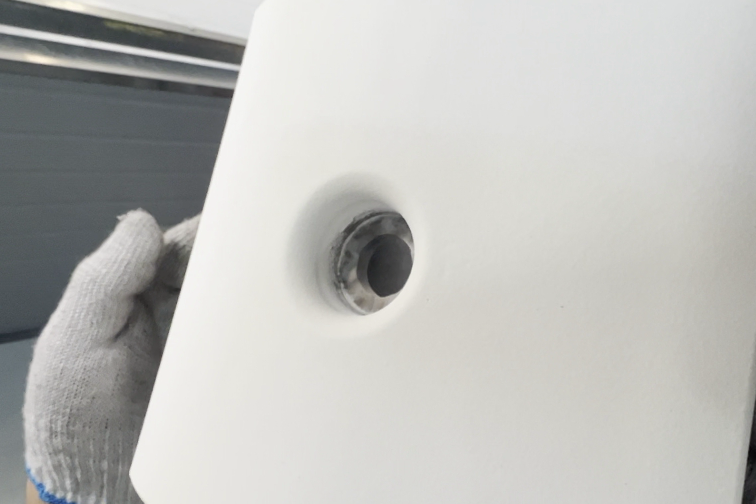Ceramic Heat-Resistant Coating for IN738LC Super Alloy Boiler Insulation Block
Introduction
IN738LC is a precipitation-strengthened nickel-based superalloy known for its excellent creep resistance, hot corrosion resistance, and mechanical strength up to 980–1050°C. In high-efficiency power boilers and turbine exhaust manifolds, IN738LC insulation blocks are often used in structural or thermal shielding roles. However, their performance can degrade over time due to oxidation and thermal cycling. Our ceramic heat-resistant coating solutions provide an essential thermal protection barrier to extend the service life of IN738LC boiler insulation blocks operating in harsh high-temperature environments.
We specialize in applying advanced plasma-sprayed ceramic coatings to superalloy components in energy systems, improving thermal stability, oxidation resistance, and insulation effectiveness.
Why IN738LC Requires Ceramic Heat-Resistant Coating
Though IN738LC offers superior base-metal performance, it is still vulnerable to:
High-temperature oxidation above 950°C
Thermal fatigue cracking from cyclic startup/shutdown
Hot corrosion from sulfur, sodium, and vanadium residues in fuel gases
Surface scaling that reduces thermal efficiency and structural stability
A ceramic thermal barrier coating (TBC) helps protect the alloy surface by reducing metal temperature, limiting oxidation, and minimizing thermal gradients.
Compatible Coating System
Coating Layer | Material | Function |
|---|---|---|
Bond Coat | NiCrAlY or MCrAlY | Provides oxidation resistance and ensures ceramic adhesion |
Top Coat | 7–8 wt% Yttria-Stabilized Zirconia (YSZ) | Thermal insulation and strain accommodation |
We apply this two-layer system via Atmospheric Plasma Spray (APS), forming a durable ceramic shell that remains stable at continuous operating temperatures of 1000–1150°C.
Plasma Coating Process Overview
1. Surface Preparation
IN738LC blocks are degreased, grit-blasted, and cleaned to ensure high surface reactivity and eliminate oxide scales.
2. Bond Coat Application
An oxidation-resistant NiCrAlY bond coat is applied using plasma spray or HVOF. It forms a thermally grown oxide (TGO) interface that stabilizes during operation.
3. YSZ Top Coat Deposition
The ceramic YSZ top coat is plasma sprayed to a thickness of 250–400 μm with controlled porosity (~10–15%) to reduce thermal conductivity and absorb mechanical strain.
4. Optional Sealing or Heat Treatment
Post-spray sealing treatments or thermal cycling may be performed to match specific boiler or exhaust design criteria.
Benefits of Ceramic Coating for IN738LC Blocks
Performance Area | Benefit |
|---|---|
Thermal Insulation | Reduces metal temperature by up to 200°C, limiting creep deformation |
Oxidation Resistance | Protects from surface scaling and internal oxidation |
Corrosion Protection | Resists sulfates, chlorides, and vanadates found in exhaust gas streams |
Extended Service Life | Increases component life during cyclic temperature operation |
Energy Efficiency | Enhances system insulation and heat retention in boiler systems |
Applications
Boiler Insulation Blocks for ultra-supercritical steam plants (e.g., IN738LC panels exposed to flue gas at 1000–1100°C)
Turbine Exhaust Shields where insulation blocks prevent heat soak into structure and instrumentation
Thermal Protection in Chemical Process Heaters
Insulating Liners in Hydrogen or Ammonia Reformers using IN738LC as base structure
Testing and Quality Assurance
We perform testing in accordance with power generation and gas turbine component standards:
Coating Thickness Measurement (±10 μm)
Bond Strength Testing (ASTM C633)
Thermal Cycling (>1000 cycles between 400°C and 1100°C)
Porosity and Microstructure Inspection (SEM cross-sections)
Oxidation Resistance Validation (TGA/EDS methods)
Results and Verification
Thermal protection: Up to 200°C reduction in metal surface temperature
Spallation resistance: >95% coating retention after 1000 thermal cycles
Oxidation depth reduction: >90% compared to uncoated IN738LC at 1050°C
Bond strength: ≥30 MPa (ASTM C633)
FAQs
What is the ideal TBC thickness for IN738LC insulation blocks?
Can ceramic coatings be reapplied after service exposure?
What environments benefit most from ceramic coating on boiler blocks?
How does TBC affect thermal conductivity and insulation performance?
What testing validates coating performance for high-temperature use?

